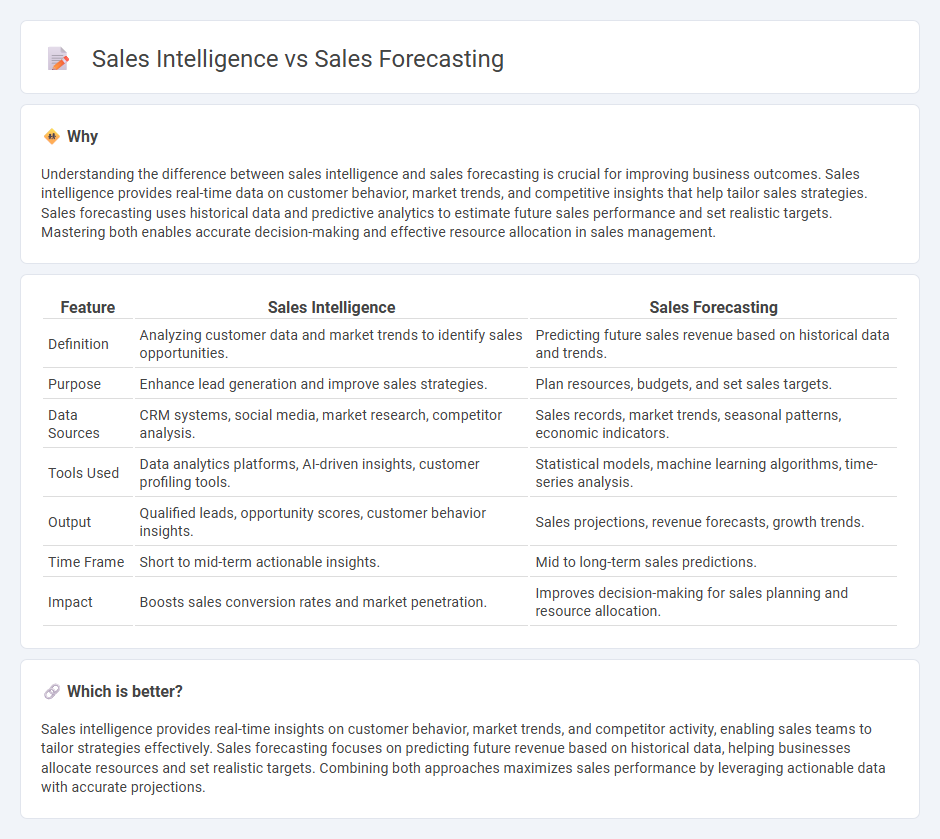
Sales intelligence uses data analytics and customer insights to identify potential leads and optimize sales strategies, focusing on actionable information from real-time market trends and buyer behaviors. Sales forecasting predicts future revenue by analyzing historical sales data, market conditions, and sales pipeline metrics, helping businesses plan resources and set achievable targets. Explore more to understand how these tools can drive revenue growth and improve sales performance.
Why it is important
Understanding the difference between sales intelligence and sales forecasting is crucial for improving business outcomes. Sales intelligence provides real-time data on customer behavior, market trends, and competitive insights that help tailor sales strategies. Sales forecasting uses historical data and predictive analytics to estimate future sales performance and set realistic targets. Mastering both enables accurate decision-making and effective resource allocation in sales management.
Comparison Table
| Feature | Sales Intelligence | Sales Forecasting |
|---|---|---|
| Definition | Analyzing customer data and market trends to identify sales opportunities. | Predicting future sales revenue based on historical data and trends. |
| Purpose | Enhance lead generation and improve sales strategies. | Plan resources, budgets, and set sales targets. |
| Data Sources | CRM systems, social media, market research, competitor analysis. | Sales records, market trends, seasonal patterns, economic indicators. |
| Tools Used | Data analytics platforms, AI-driven insights, customer profiling tools. | Statistical models, machine learning algorithms, time-series analysis. |
| Output | Qualified leads, opportunity scores, customer behavior insights. | Sales projections, revenue forecasts, growth trends. |
| Time Frame | Short to mid-term actionable insights. | Mid to long-term sales predictions. |
| Impact | Boosts sales conversion rates and market penetration. | Improves decision-making for sales planning and resource allocation. |
Which is better?
Sales intelligence provides real-time insights on customer behavior, market trends, and competitor activity, enabling sales teams to tailor strategies effectively. Sales forecasting focuses on predicting future revenue based on historical data, helping businesses allocate resources and set realistic targets. Combining both approaches maximizes sales performance by leveraging actionable data with accurate projections.
Connection
Sales intelligence leverages data analytics and customer insights to identify opportunities and optimize sales strategies, directly enhancing the accuracy of sales forecasting. By integrating real-time market trends, competitor analysis, and customer behavior patterns, sales forecasting models become more precise and actionable. This connection enables sales teams to predict revenue, allocate resources effectively, and improve overall sales performance.
Key Terms
**Sales Forecasting:**
Sales forecasting uses historical data, market trends, and predictive analytics to estimate future sales performance, enabling businesses to allocate resources efficiently and set realistic revenue targets. Techniques include time series analysis, regression models, and machine learning algorithms that improve accuracy over time. Explore detailed methodologies and tools to enhance your sales forecasting process.
Pipeline Analysis
Sales forecasting predicts future revenue by analyzing historical sales data, market trends, and customer behavior to guide strategic decisions. Sales intelligence enhances pipeline analysis by providing real-time insights into prospects, lead quality, and competitive positioning, enabling more accurate targeting and resource allocation. Explore the key differences between sales forecasting and intelligence to optimize your pipeline analysis strategy.
Historical Data
Sales forecasting leverages historical sales data to predict future revenue trends and customer demand, using patterns from previous periods to create accurate projections. Sales intelligence, on the other hand, analyzes historical data combined with real-time market insights and competitor activities to enhance strategic decision-making and identify growth opportunities. Discover how integrating historical data optimizes both sales forecasting and sales intelligence for improved business outcomes.
Source and External Links
Sales Forecasting | Salesforce - This guide provides insights into creating a sales forecast, including defining the forecast period, gathering data, selecting forecasting methods, and analyzing trends to predict future sales.
Sales Forecasting 101: The Ultimate Guide - This resource covers the basics of sales forecasting, including how to forecast unit sales per month and using trend analysis and exponential smoothing for predictions.
How To Calculate Sales Forecast: Formulas, Steps, and Examples - Provides steps and techniques for calculating a sales forecast, including tracking financial data, determining the sales cycle, and using formulas to predict future sales.
 dowidth.com
dowidth.com